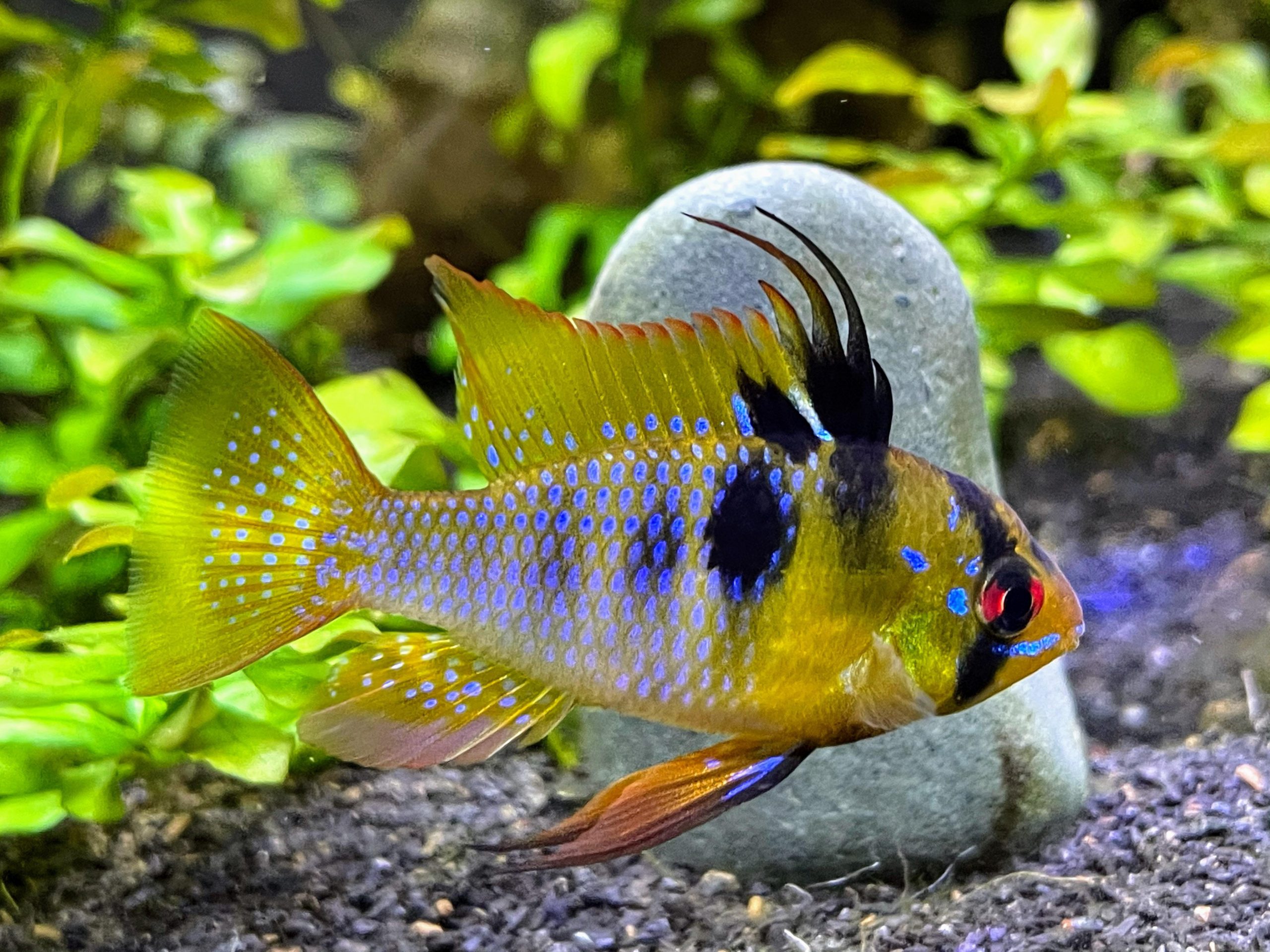Ram Cichlid
A Jewel in the Aquarium: A Comprehensive Guide to Caring for Ram Cichlids
Often admired for their vibrant colours and engaging personalities, Ram Cichlids (Mikrogeophagus ramirezi) are a popular and rewarding choice for many aquarists. These dwarf cichlids, native to the slow-moving, warm waters of the Orinoco River basin in Venezuela and Colombia, bring a splash of the Amazon to the home aquarium. This in-depth guide will provide you with everything you need to know to successfully care for and even breed these captivating fish.
Natural Habitat and Appearance
In the wild, Ram Cichlids inhabit waters that are soft, acidic, and often stained with tannins from decaying leaves. They seek refuge and foraging opportunities amongst dense vegetation, submerged roots, and leaf litter. Understanding their natural environment is key to replicating a suitable habitat in an aquarium.
Rams are a sexually dimorphic species, meaning males and females have distinct differences. Males are typically larger, reaching up to 7cm, and exhibit more extended dorsal fin rays. Females are slightly smaller and possess a characteristic pinkish-red belly, which becomes more pronounced during spawning. Both sexes display a stunning array of colours, including electric blues, sunny yellows, and fiery oranges, often with a prominent dark spot on their flank and a vertical black stripe through the eye. Several captive-bred varieties exist, including the popular German Blue, Electric Blue, and Gold Rams, each with unique and intensified colouration.
Setting Up the Ideal Ram Aquarium
A well-planned aquarium is crucial for the health and happiness of your Ram Cichlids. Due to their relatively small size, a minimum tank size of 75 litres (20 gallons) is recommended for a pair.
Substrate and Decor: A soft, sandy substrate is ideal as Rams enjoy sifting through it for food, a natural behaviour. The decor should provide plenty of hiding places and territories. Driftwood, smooth rocks, and caves are excellent additions. Dense planting with live plants not only mimics their natural habitat but also helps to maintain water quality and provides a sense of security.
Filtration and Water Movement: Filtration should be efficient to maintain pristine water conditions, but the water flow should be gentle. Rams are not accustomed to strong currents. An external canister filter with a spray bar or a sponge filter are good options.
Water Parameters: The Key to Success
Ram Cichlids are more sensitive to water conditions than many other community fish. Maintaining stable parameters is paramount to their well-being.
| Water Parameter | Recommended Range | Notes |
|---|---|---|
| Temperature | 24°C – 30°C (75°F – 86°F) | Warmer temperatures can induce breeding. |
| pH | 5.5 – 7.0 | A slightly acidic environment is preferred. |
| Hardness (GH) | 1-10 dGH | Soft water is essential for long-term health. |
| Ammonia | 0 ppm | Highly toxic to Rams. |
| Nitrite | 0 ppm | Highly toxic to Rams. |
| Nitrate | < 20 ppm | Keep as low as possible with regular water changes. |
Regular water changes of 25-50% weekly are essential to keep nitrate levels low and the water clean. Using a good quality dechlorinator is a must. To help create the desired soft, acidic water, consider using reverse osmosis (RO) water mixed with a small amount of tap water or specific remineralising products. The addition of Indian almond leaves or peat to the filter can also help to lower the pH and release beneficial tannins.
A Varied Diet for Vibrant Health
Ram Cichlids are omnivores and thrive on a varied diet. A high-quality flake or small pellet food can form the staple of their diet. This should be supplemented with a regular offering of live or frozen foods to ensure they receive all the necessary nutrients for optimal health and colouration.
Recommended Foods:
- Frozen: Bloodworms, brine shrimp, daphnia, mysis shrimp.
- Live: Brine shrimp, daphnia, white worms.
- High-Quality Pellets/Flakes: Choose a brand specifically formulated for cichlids.
Feed small amounts once or twice a day, only giving what they can consume in a few minutes to avoid overfeeding and polluting the tank.
Peaceful Community Dwellers: Choosing Tank Mates
Despite being cichlids, Rams are generally peaceful and can be kept in a community aquarium with other calm and similarly sized fish. Aggressive or boisterous tank mates will cause stress and should be avoided.
| Suitable Tank Mates | Unsuitable Tank Mates |
|---|---|
| Cardinal Tetras | Large, aggressive Cichlids (e.g., Oscars) |
| Rummy Nose Tetras | Fast-moving, boisterous fish (e.g., some larger Barbs) |
| Ember Tetras | Fin-nippers (e.g., Tiger Barbs) |
| Corydoras Catfish | Most other Cichlids (territorial disputes) |
| Otocinclus Catfish | |
| Small Rasboras | |
| Pencilfish |
It’s best to introduce Rams to an established aquarium with existing peaceful inhabitants.
The Rewarding Challenge of Breeding Ram Cichlids
Breeding Ram Cichlids can be a fascinating experience. To encourage spawning, the water temperature should be raised to the higher end of their preferred range (28°C – 30°C), and the water should be very soft and acidic (pH 5.5-6.5).
The pair will select a flat surface, such as a smooth rock, a broad plant leaf, or even a depression they dig in the substrate, to lay their eggs. Both parents will diligently guard the eggs and fan them with their fins to ensure good oxygenation. The eggs typically hatch in 2-3 days, and the fry will become free-swimming a few days later.
Initially, the fry should be fed infusoria or a commercially available liquid fry food. As they grow, they can be moved on to newly hatched brine shrimp and crushed flake food. The parent Rams will continue to protect their young, herding them around the aquarium.
Common Health Issues
Ram Cichlids are susceptible to common freshwater fish diseases, particularly if water conditions are not optimal.
- Ich (White Spot Disease): This parasitic infection appears as small white spots on the fish’s body and fins. It is often triggered by stress, which can be caused by poor water quality or fluctuating temperatures. Treatment typically involves raising the aquarium temperature and using a proprietary white spot treatment.
- Hole in the Head (HITH): This disease can manifest as pits or lesions on the head and lateral line. The exact cause is debated but is often linked to poor water quality, nutritional deficiencies, and the presence of the parasite Hexamita. Treatment involves improving diet and water conditions, and in some cases, medication may be required.
- Bacterial Infections: These can present as fin rot, cloudy eyes, or ulcers. Maintaining excellent water quality is the best prevention. Treatment with antibacterial medications may be necessary.
By providing a stable and suitable environment, a high-quality diet, and peaceful tank mates, you can enjoy the beauty and engaging behaviour of Ram Cichlids for their entire lifespan, which is typically 2-3 years. These stunning little cichlids are a true jewel in any aquarium and a testament to the wonders of the aquatic world.


